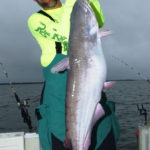
Find the buffet line and you’ll find gamefish
January’s unpredictable weather, along with cold water temperatures, is a given, and it makes targeting a single species of fish on the Santee Cooper lakes risky in terms of enjoying good action — but fast action and quality fish are available. A key is to allow the weather and water conditions to dictate what’s best at any given time.
The potential for fast action is excellent if you approach the process with an open mind. A good example is that excellent striped bass fishing often lingers into January if the weather and water don’t get frigid. If the weather turns very cold early, and the forage gangs up into tight pods in deep water, catching stripers can be tough. But fishing for blue catfish becomes energized because those same pods of shad congregate blue catfish in tremendous numbers, and they have insatiable appetites.
Crappie fishing has the same tendency to vary from relatively good, shallow-water action to a deep and slow bite. Largemouth bass provide good fishing at times, but their location can change dramatically over the course of the month.
If such a thing as “normal” actually exists, late-December and early January should produce some excellent striper fishing, particularly for big fish.
Guide Kevin Davis at Blacks Camp (843-312-3080) said fishing will usually be good on both lakes, but he will target Lake Moultrie near Pinopolis Dam.
“I like the deep water this time of year for stripers,” Davis said. “It allows more options in terms of depth to find fish. The most-consistent bite is typically on live bait, but the possibility of stripers schooling exists. I’d suggest being rigged for schooling fish, but plan on live bait as the primary method, with herring, shad or even big shiners being good options.”
On Lake Marion, guide Alan Spence said the best striper option is often major creeks: Wyboo, Potato and Taw Caw.
“With the water cooling off, often we’ll have a big migration of shad into the big creeks, and that’s where the stripers will go — following the forage,” Spence said. “Live shad make great bait since that’s the primary forage right now. The shad are usually the key as to where to fish, so use the graph to find shad and set up to drift over the schools of shad, or anchor if you find a really large school of shad.”
Spence (803-478-5029) said as the water temperature drops, shad often get into very large schools, and the striper bite can be very consistent. If schools are smaller and scattered, drifting live bait can be very effective.
As the action begins to slow with falling water temperatures, catfish action can get into high gear.
Retired guide Don Drose said to stay on really good fishing action, he would make that transition.
“I’d usually experience a pretty fast change once the water temperature really dipped, and we’d go from catching lots of stripers to very few in a matter of days,” he said. “But by changing species and hitting the blue catfish that are targeting the shad schools, we could have sensational fishing.”
Drose said he’ll catch shad with a cast net, mark schools on his graph and target those showing a lot of big fish arches around and under the forage. Hook a couple of small threadfin shad and drop them to the depth the fish are marked, and the action should begin quickly. If not, or when it slows, move on to another school and repeat the process.”
The same transition occurs in Lake Moultrie; Davis said the deep water near Pinopolis Dam remains the key area.
“The catfish will usually be suspended, and it will be a function of how deep the bait is,” he said. “This can change daily with a bright day, overcast day or rapidly dropping water temperature. But the process is the same: use the graph to find the forage and fish combination. I fish vertically with a straight-shank hook instead of a circle hook for this specific fishing. A circle hook is great for drift-fishing, but I use a 2-ounce sinker to keep my line straight down and use a live or cut gizzard shad, herring and menhaden, if you can catch them. This is big-fish time, as well as a good time for numbers of quality fish.”
Water temperatures will dictate crappie movements ,and fish will often be caught tight-lining live minnows or small jigs tipped with minnows over brush in deep water.
In the upper end of Lake Marion, Steve Pack out of Packs Landing (803- 452-5514) said January, primarily later in the month, can be excellent for crappie in years when the weather warms a bit later in the month.
“It may not happen every year, but often we’ll have some sensational crappie fishing in January and into February in water much shallower than most would expect,” Pack said. “We’ll use live minnows as well as jigs and jigs tipped with minnows, and we’ll work around trees, logs and other woody cover. Often the fish will be in water less than 10 feet deep.”
Largemouth bass anglers are going to catch fish year-round, but January can be a tough time to find a pattern that holds consistent for any substantial length of time. Bottom bumpers are good in the main lake and red-pattern crankbaits in the upper end of Lake Marion are productive.
Live-bait fishing with shiners offers good potential for hooking big fish in the shallow areas of both lakes.




Be the first to comment